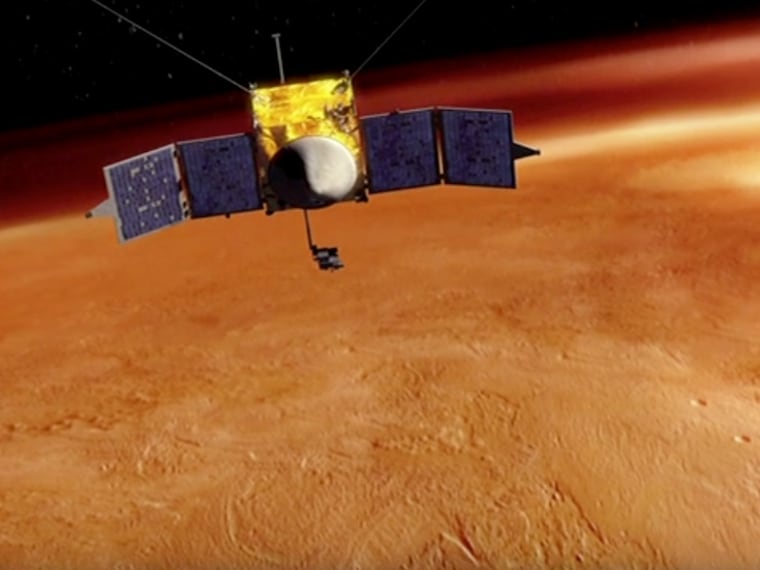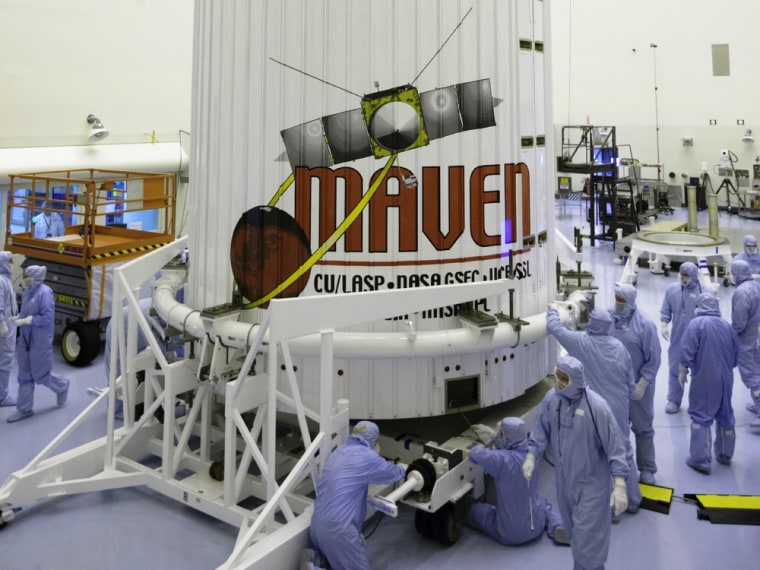
NASA's Maven orbiter is designed to follow up on a huge question surrounding past findings about Mars: If the Red Planet was once far more hospitable to life, what happened?
"What I'm most looking for is clarity," the University of Colorado's Dave Brain, a co-investigator for the $670 million mission, told NBC News. "We're very certain that Mars has undergone some big change over the last several billion years."
Part of that big change had to do with Mars' atmosphere: Past studies have suggested that the carbon dioxide atmosphere was once thicker and more Earthlike, which would have kept the planet warmer and wetter. Now the atmospheric density is just 1 percent of Earth's, offering little protection from the sun's deadly ultraviolet blast. Where did the air go?
"There are only two answers to that question: You can go down, or you can go up," Brain said.
One recent study suggested that the atmosphere was stripped away from above. In that scenario, energetic solar storms and cosmic rays might have blasted atmospheric molecules into space, and that process might be continuing even today.
"In many regards, Mars is the planet most similar to Earth, but it differs from Earth in a big but subtle way: Earth has a global magnetic field, Mars does not. We think that a global magnetic field can be a very good shield for the atmosphere," Brain said.
Another study, however, suggested that significant amounts of CO2 were trapped in Martian rocks as carbonates, types of minerals that contain carbon and oxygen. So was the air lost by flying up into space, or sinking down into the rocks? "The answer most certainly is both, and the answer might not be one process for all time," Brain said.
What Maven will do
NASA's Maven spacecraft, scheduled for launch from Cape Canaveral Air Force Station on Nov. 18, is carrying three suites of instruments to sort out what's happening to Mars' atmosphere. It's due to reach Martian orbit next September. "Maven" is an acronym of sorts, standing for Mars Atmosphere and Volatile EvolutioN. That phrase summarizes the focus of Maven's observations.

"Previous spacecraft have been to Mars with some of the instruments," Brain said. "We have measured charged particles escaping from the atmosphere before. What makes Maven a strong mission is that we've never before had all the instruments we've needed to answer these questions on the same spacecraft at the same time."
Maven will measure the current composition of Mars' upper atmosphere, monitor the rate at which different chemicals in the atmosphere are escaping into space, and study the effects of the solar wind. Those readings could help answer many of the questions about the Red Planet's past.
There's one question that Maven won't be able to answer directly, however — and that's the one having to do with methane on Mars. Some studies have detected enough methane in the Red Planet's atmosphere to hint at a biological source. However, NASA's Curiosity rover found no trace of the gas at the Martian surface.

Brain said Maven's mission managers considered whether it would be worthwhile to tweak the spacecraft's instruments to detect methane, but decided that "modifying that science came at an expense, and therefore would possibly jeopardize our ability to accomplish the original mission objectives." Instead, scientists might look to India's just-launched Mars Orbiter Mission for more clarity on the methane question.
Why does all this matter? Brain says Maven could help scientists compare the climate histories of Mars and Earth — and perhaps reveal how one planet became cold and forbidding, while the other planet stayed warm and welcoming to life as we know it.
"When we think about climate and habitability, Earth is all we know about right now," he said. "But wouldn't it be neat if, long ago, Mars looked like Earth?"
Brain is joining me for an online chat about the Maven mission on "Virtually Speaking Science," a talk show that airs at 8 p.m. ET Wednesday via Blog Talk Radio and in the Exploratorium's virtual auditorium in Second Life. Join the virtual audience, listen to the hourlong show live online, or download the podcast anytime via Blog Talk Radio or iTunes. You can send in questions via Twitter, using the hashtag #askVS. And while you're at it, check out these archived shows from "Virtually Speaking Science":
- Phil Plait on detecting pseudo-scientific B.S.
- Roger Pielke Jr. on the outlook for climate policy
- Joy Crisp and Doug Turnbull on Curiosity's year on Mars
- James Oberg on Apollo 11's legacy
- SETI Institute's Seth Shostak on aliens in the movies
- Brian Switek on dinosaur fact and fiction
- George Djorgovski on the Internet and education
- Doug Griffith and Taber MacCallum on moon and Mars trips
- Sean Carroll and Matt Strassler on physics' X Files
- Ig Nobel's Marc Abrahams on weird science in 2012
- Paul Doherty on Curiosity and the year in science
- Shawn Lawrence Otto on climate change and the 2012 election
- Sean Carroll on what lies beyond the Higgs boson
- Alan Stern on the Uwingu mystery space venture
- George Djorgovski on the future of immersive virtual reality
- JPL's Dave Beaty previews Curiosity's mission on Mars
- SETI Institute's Seth Shostak about aliens and UFOs
- Paul Doherty on solar eclipses and the transit of Venus
- Veronica Ann Zabala-Aliberto on spaceflight and Yuri's Night
- JPL's Dave Beaty on the search for life on Mars
- Shawn Lawrence Otto on science and politics
- Ig Nobel impresario Marc Abrahams on silly science in 2011
- Rocket scientist Robert Zubrin on Mars exploration
- Propulsion expert Marc Millis on interstellar spaceflight
- Sean Carroll on the puzzles facing physicists
- Rand Simberg on the private-enterprise vision for spaceflight
- Martin Hoffert on the future of energy policy
- George Djorgovski on science in virtual worlds
- Alan Stern on suborbital research and NASA's mission to Pluto
- Col. 'Coyote' Smith on the outlook for space solar power
- Tim Pickens on rocket ventures and the Google Lunar X Prize
Alan Boyle is NBCNews.com's science editor. Connect with the Cosmic Log community by "liking" the NBC News Science Facebook page, following @b0yle on Twitter and adding +Alan Boyle to your Google+ circles. To keep up with NBCNews.com's stories about science and space, sign up for the Tech & Science newsletter, delivered to your email in-box every weekday. You can also check out "The Case for Pluto," my book about the controversial dwarf planet and the search for new worlds.
